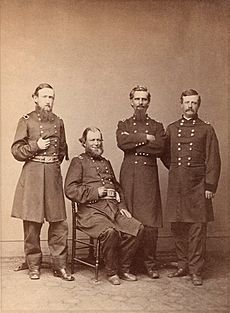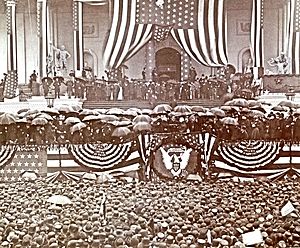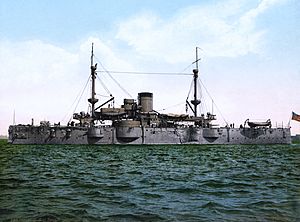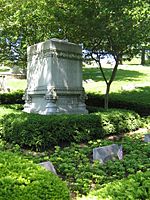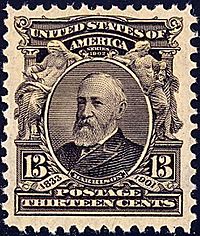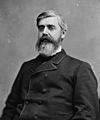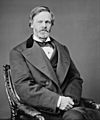Benjamin Harrison facts for kids
Quick facts for kids
Benjamin Harrison
|
|
|---|---|
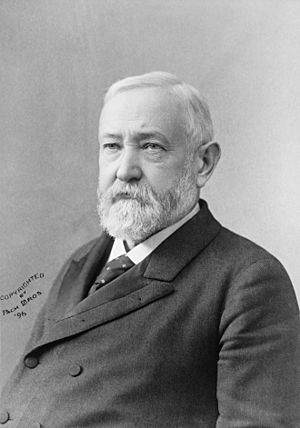 |
|
| 23rd President of the United States | |
| In office March 4, 1889 – March 3, 1893 |
|
| Vice President | Levi P. Morton |
| Preceded by | Grover Cleveland |
| Succeeded by | Grover Cleveland |
| United States Senator from Indiana |
|
| In office March 4, 1881 – March 4, 1887 |
|
| Preceded by | Joseph McDonald |
| Succeeded by | David Turpie |
| Personal details | |
| Born | August 20, 1833 North Bend, Ohio |
| Died | March 13, 1901 (aged 67) Indianapolis, Indiana |
| Cause of death | Influenza-related pneumonia |
| Nationality | American |
| Political party | Republican |
| Spouses | Caroline Scott Harrison (1st wife) Mary Scott Lord Dimmick (2nd wife) |
Benjamin Harrison (August 20, 1833–March 13, 1901) was the 23rd president of the United States (1889-1893). He was the grandson of President William Henry Harrison and the only grandson of a president to himself become president. His home was in Indianapolis, Indiana.
He was a member of the Republican party and was elected to the White House in 1888, beating the incumbent, Grover Cleveland. After Harrison served one full four-year term as president, Cleveland ran again and, this time, beat Harrison.
During the American Civil War Harrison was a colonel in the Union Army (later a brevet brigadier general).
He was also a successful lawyer, arguing many cases before the United States Supreme Court.
Contents
Early life
Harrison was born on August 20, 1833, in North Bend, Ohio, the second of Elizabeth Ramsey (Irwin) and John Scott Harrison's ten children.
Harrison was a grandson of U.S. President William Henry Harrison and a great-grandson of Benjamin Harrison V, a Virginia planter who signed the Declaration of Independence and succeeded Thomas Nelson, Jr. as governor of Virginia.
Harrison's boyhood was enjoyable, much of it spent outdoors fishing or hunting.
Harrison's early schooling took place in a log cabin near his home, but his parents later arranged for a tutor to help him with college preparatory studies. He then went to college.
Early career and marriage
After his college graduation in 1852, Harrison studied law with Judge Bellamy Storer of Cincinnati, but before he completed his studies, he returned to Oxford, Ohio, to marry Caroline Scott on October 20, 1853.
The Harrisons had two children, Russell Benjamin Harrison (August 12, 1854 – December 13, 1936) and Mary "Mamie" Scott Harrison (April 3, 1858 – October 28, 1930).
Harrison began practicing law in 1854.
From 1862 - 1865 he served as a Union Army commander in the American Civil War.
Harrison served as a senator for Indiana from March 4, 1881, to March 3, 1887.
Presidency (1889–1893)
Benjamin Harrison as president wanted to increase tariffs (a tax on goods that come into the country) for two reasons:
- First, it gave more money to the U.S. government, so it could fund important things.
- Second, because he believed in protectionism. He thought a high tariff would encourage Americans to make more of their own things instead of buying them from foreign countries.
Harrison spent the money received from the tariffs to give money to injured American Civil War veterans.
Harrison was the first president to have a billion dollar budget for the government. People criticized him for that.
He also signed the Sherman Anti-Trust Act which gave the U.S. government the power to regulate big businesses.
His first wife Carrie Harrison died in 1892.
During Harrison's time in office, the United States was continuing to experience advances in science and technology. A recording of his voice is the earliest extant recording of a president while he was in office. That was originally made on a wax phonograph cylinder in 1889 by Gianni Bettini. Harrison also had electricity installed in the White House for the first time by Edison General Electric Company, but he and his wife would not touch the light switches for fear of electrocution and would often go to sleep with the lights on.
Over the course of his administration, Harrison marshaled the country's technology to clothe the nation with a credible naval power. When he took office there were only two commissioned warships in the Navy. In his inaugural address he said, "construction of a sufficient number of warships and their necessary armaments should progress as rapidly as is consistent with care and perfection." Harrison's Secretary of the Navy Benjamin F. Tracy spearheaded the rapid construction of vessels, and within a year congressional approval was obtained for building of the warships Indiana, Texas, Oregon, and Columbia. By 1898, with the help of the Carnegie Corporation, no less than ten modern warships, including steel hulls and greater displacements and armaments, had transformed the United States into a legitimate naval power. Seven of these had begun during the Harrison term.
States admitted to the Union
More states were admitted during Harrison's presidency than any other. They are:
- North Dakota – November 2, 1889
- South Dakota – November 2, 1889
- Montana – November 8, 1889
- Washington – November 11, 1889
- Idaho – July 3, 1890
- Wyoming – July 10, 1890
Post-presidency and death (1893–1901)
In 1896, Harrison at age 62 remarried, to Mary Scott Lord Dimmick. Benjamin and Mary had one child together, Elizabeth (February 21, 1897 – December 26, 1955).
Harrison died from pneumonia at his home in Indianapolis on March 13, 1901, at the age of 67. Harrison's remains are interred in Indianapolis's Crown Hill Cemetery, next to the remains of his first wife, Caroline. After her death in 1948, Mary Dimmick Harrison, his second wife, was buried beside him.
Legacy
Harrison was memorialized on several postage stamps. The first was a 13-cent stamp issued on November 18, 1902, with the engraved likeness of Harrison modeled after a photo provided by his widow. In all Harrison has been honored on six U.S. Postage stamps, more than most other U.S. Presidents. Harrison also was featured on the five-dollar National Bank Notes from the third charter period, beginning in 1902. In 2012, a dollar coin with his image, part of the Presidential $1 Coin Program, was issued.
In 1908, the people of Indianapolis erected the Benjamin Harrison memorial statue, created by Charles Niehaus and Henry Bacon, in honor of Harrison's lifetime achievements as military leader, U.S. Senator, and President of the United States. The statue occupies a site on the south edge of University Park, facing the Birch Bayh Federal Building and United States Courthouse across New York Avenue.
In 1951, Harrison's home was opened to the public as a library and museum. It had been used as a dormitory for a music school from 1937 to 1950. The house was designated as a National Historic Landmark in 1964.
Interesting facts about Benjamin Harrison
- Benjamin Harrison was the 23rd President of the United States
- He was the first president of the United States to use electricity in the White House.
- Harrison was seven years old when his grandfather William Henry Harrison was elected U.S. president, but he did not attend the inauguration.
- He had a few nicknames but the most famous was “The Human Iceberg” because he had a stiff and cold personality.
- He was obsessed with germs and always wore gloves when he was shaking hands with people.
- When he was elected in 1889 he was known as the “Centenial President” because it was 100 years since George Washington had first become President in 1789.
Images for kids
-
Birthplace marker in North Bend, Ohio
-
Harrison during the Battle of Resaca leading the 70th Indiana, May 1864; Harrison was a colonel at the time.
-
Battle of Resaca, in Georgia, where Harrison served under General Sherman
-
Walter Q. Gresham, Harrison's rival within the Indiana Republican Party
-
Eastman Johnson's portrait of Benjamin Harrison, c. 1890–1900
-
Senator John Sherman worked closely with Harrison, writing bills regulating monopolies and monetary policy.
-
Harrison with Secretary Blaine and Representative Henry Cabot Lodge off the coast of Maine, 1889
-
Harrison's cabinet in 1889 Front row, left to right: Harrison, William Windom, John Wanamaker, Redfield Proctor, James G. Blaine Back row, left to right: William H. H. Miller, John Willock Noble, Jeremiah M. Rusk, [[Benjamin F. Tracy
-
Official White House portrait of Benjamin Harrison, painted by Eastman Johnson
See also
 In Spanish: Benjamin Harrison para niños
In Spanish: Benjamin Harrison para niños


